Variety of green vegetable basil “Tonus”: growing from seeds for beginners
Basil is not only a medicinal plant, but also a favorite spice of many cooks. To grow it at home from seeds, you need to choose a suitable variety (for example, Tonus) and follow the rules of agricultural technology; then even a novice gardener will be able to do it. We will tell you about the rules of sowing and care in the article.
All about Basil Tonus
Basil Tonus is an annual plant with a spicy taste.. It has green, succulent leaves and white inflorescences. This is a mid-season variety that ripens within 76 days (from the first shoots to flowering). Belongs to the Lamiaceae family.

History of origin and distribution
Asian countries - Iran, India, Sri Lanka - idolized basil. It was believed that the spicy aroma could lead the deceased to the afterlife. In European countries they were wary of this plant, believing that it was cursed.
It took several centuries for basil to become appreciated and grown in Europe. In the 16th century, Greece was the first to surrender, followed by Italy and France. The seasoning began to be added to meat dishes, drinks, and desserts. Fragrant basil gained fame and became a symbol of family well-being and fertility.
The basil variety Tonus was first grown in northwestern Italy, near the city of Genoa. From the place of origin it received its other name - Genoese basil.
Differences from other varieties
The main distinguishing features of the Tonus variety are::
- Bright green leaf color. Most varieties are purple, black-violet, or purplish-violet.
- Soft taste, thanks to which it is used in cooking for preparing sweet dishes. Purple varieties have a sharp, rich flavor and are used as a seasoning for meat dishes and fish.
- Delicate aroma. Tone is used to prepare refreshing drinks. Other varieties have a pungent odor.
Advantages and disadvantages
The main advantages of the Tonus variety:
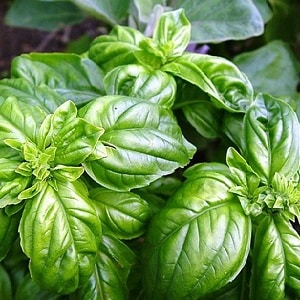 Pleasant aroma and mild taste.
Pleasant aroma and mild taste.- Growing from seeds and seedlings will not be difficult for both experienced and novice gardeners.
- The small size of the bush allows you to grow the plant on a windowsill and always have fresh herbs on hand for preparing various dishes, pickles, drinks, and seaming for future use.
- Easy to use for making face masks, add to a decoction for rinsing hair.
Disadvantages of the Tonus variety:
- Due to its mild taste, it is not suitable for preparing spicy dishes.
- The plant does not like high humidity and heavy soil.
- Does not tolerate temperature changes well, especially in early spring.
Characteristics and description
Vegetable basil Tonus reaches a height of 35-50 cm. The plant has medium-sized light green leaves with finely toothed edges, reaching a length of 5.5-7 cm. It grows as a neat spreading bush, oriented vertically.
Basil Tonus has a delicate, spicy aroma. Leaves with a mild, slightly tart taste.
Features of the chemical composition
Basil is rich in chemical elements. 100 g of green leaves contain vitamins and microelements:
- A – 264 mcg;
- B1 – 0.034 mg;
- B2 – 0.076 mg;
- B4 – 11.4 mg;
- B9 – 68 mcg;
- C – 18 mg;
- K – 414.8 mcg;
- PP – 0.902 mg;
- potassium – 295 mg;
- magnesium – 64 mg;
- sodium – 4 mg;
- phosphorus – 56 mg;
- manganese – 1.148 mg;
- copper – 385 mcg;
- iron – 3.17 mcg.
Calorie content of fresh basil is 23 kcal per 100 g of product.
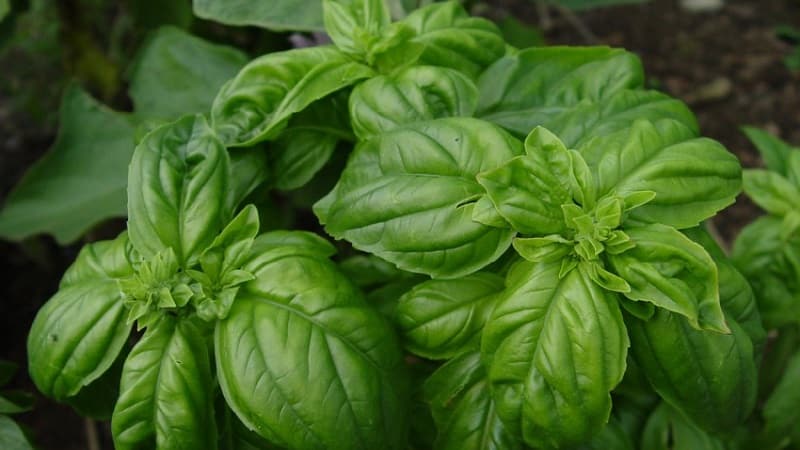
Durability
The variety tolerates air temperatures above +25°C well. Resistant to fusarium and gray rot. The spicy smell repels various pests, such as caterpillars and spider mites. Therefore, gardeners try to plant basil next to other plants on the site, using its aroma to protect them.
On a note! At temperatures above +20°C, basil does not bloom for a long time - this is a characteristic feature of the Tonus variety.
Application area
The main area of application of the plant is in cooking. Aromatic spice is used:
- as a seasoning for meat and fish dishes;
- as an ingredient in refreshing drinks;
- when baking sweets, cakes;
- for marinating and pickling vegetables.
Contained in the basilica essential oils are successfully used in hair care products. Vitamins saturate the hair follicle, accelerate hair growth, and prevent hair loss.
Basil oil prevents the formation of premature wrinkles, nourishes and moisturizes the skin, which is why it is added to skin care products.
Green basil – it is a natural antibiotic. It relieves toothache and menstrual pain.
Features of growing seeds/seedlings
To obtain strong basil seedlings Tonus practice growing from seeds. No special preparation is required for germination.
In the ground
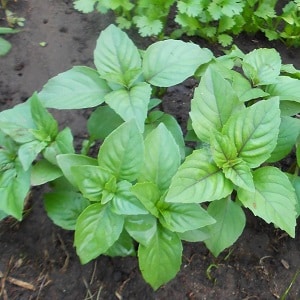 Sowing basil seeds in open ground begins in mid-April.. Prepare the soil in advance from:
Sowing basil seeds in open ground begins in mid-April.. Prepare the soil in advance from:
- compost - 4 parts;
- humus - 2 parts;
- river sand - 1 part.
Seeds are sown in moistened shallow grooves up to 1 cm, sprinkle with soil and lightly tap with your hand. The distance between the holes is 5 cm.Cover with glass or thick polyethylene, creating a greenhouse effect. The first shoots will appear in 1014 days.
Important! The air temperature must be at least +20°C.
In the greenhouse
When the first 2-3 true leaves appear, the seedlings are picked and planted in a greenhouse. Care consists of timely watering. It is important to avoid waterlogging or drying out, as this will have a bad effect on the seedlings.
After 6-8 leaves appear, pinch out grown basil seedlings. This stimulates the plant to send out new green shoots.
14 days before the planned planting in open ground, seedlings must be hardened. To do this, open the greenhouse for several hours during the day to provide fresh air. The air temperature inside the greenhouse is reduced by 5-7°C.
At home
If there is no land, Basil is grown at home on the windowsill. Seeds are planted regardless of weather conditions in late February - early March.
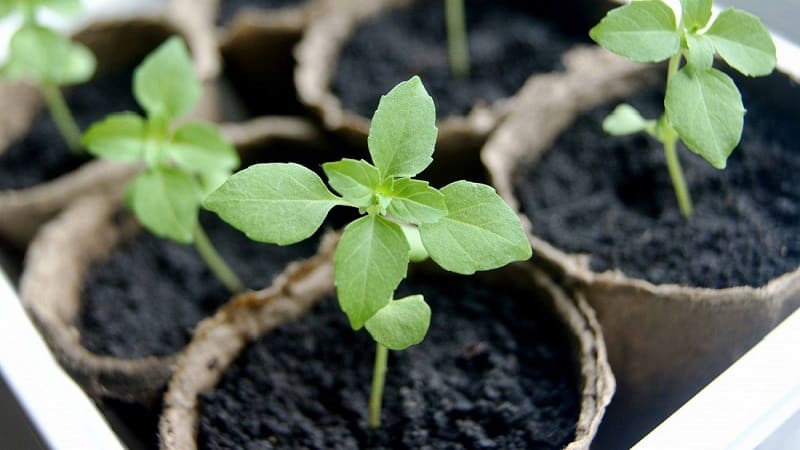
For seedlings you will need a small container, box or flower pot:
- Basil seeds are first soaked in a weak solution of potassium permanganate. for germination sprouts and disinfection.
- Seeds are sown in peat pots, sprinkled with soil. Sowing depth – 1 cm.
- The soil is light, fertilized, fertile black soil.
- When the first shoots appear, the peat pot is placed in a large container (box, flower pot) with drainage at the bottom in the form of small pebbles or expanded clay. Free spaces on the sides are filled with soil.
- Place it on a well-lit windowsill and water it periodically.
The soil is loosened 2 times a week. When the bushes reach a height of 10-12 cm, they are cut and used in cooking. New shoots will appear in place of the cut ones.
Growing technology
For successfully growing basil at home basic care rules must be followed.
Optimal conditions
The most favorable conditions for growth:
- The soil. The soil must be fertile, loose, and well-permeable to moisture and air. Acidic, clayey, heavy soil is not suitable for basil.
- Choosing a landing site. The plant loves open, well-lit areas. There should be no strong gusts of wind or prolonged exposure to sunlight. The interval between replanting in the old place is 5 years.
- Air humidity – at least 35%.
- The plant does not develop well if the soil is very wet, but it does not tolerate drought.
- Planted in the ground only with the onset of stable warm days. Basil does not tolerate frost or changes in night and day temperatures. The minimum temperature for disembarkation is +16°C, the maximum is +20°C.
Landing dates and rules
Planting seedlings in open ground is carried out from late May to early June. A month before planting, it is necessary to prepare the soil - dig up and remove grass rhizomes, add leaf compost and humus.
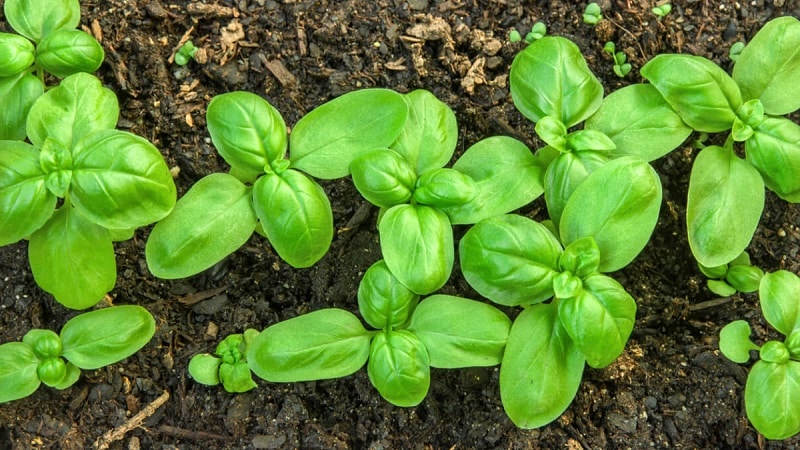
Following actions:
- Make small grooves or holes 35 cm deep. The distance between seedlings is 15-20 cm, between beds - 50-60 cm.
- Water the holes with warm, settled water.
- Plant the seedlings and cover with soil, pressing down lightly.
It is recommended to plant seedlings in the evening or on a cloudy day.. Then the young seedlings will take root better.
Further care
Water the basil as the soil dries out.. Since the plant does not like too much humidity and stagnation of water, in the summer, watering is carried out 2 times a week with settled warm water.
2 weeks after planting, basil is fed “Nitrophoska” – 2 tbsp. l.for a 12 liter bucket. A month after planting, nitrogen fertilizer is applied to stimulate green growth.
It is important to loosen the soil in a timely manner between the rows and under the bush. Do this after each watering the next day so that the soil does not become crusty and allows air to pass well to the roots.
To obtain thick greens, it is recommended regularly pinch the top shoots at the level of 6-8 leaves and remove new inflorescences.
On a note! The first greens are cut off as soon as the shoots reach a height of 10-12 cm. New ones will grow in their place. During the season, the harvest is obtained from 3 to 5 times.
Possible problems, diseases, pests
If the rules of care are not followed, the basil will get sick.:
- Fusarium – brown spots on the leaves. The reason is that the soil is depleted. It is necessary to apply potassium fertilizers.
- Blackleg – the stem rots at the base. Appears from waterlogging of the soil. For treatment, treat with potassium permanganate or copper sulfate. The solution is prepared at the rate of 1 tsp. vitriol per 1 liter of water.
- Gray rot – gray spots appear on the leaves, the stem becomes thinner. Treat with infusion of onion peels.
Due to a decrease in air temperature to +15°C or fluctuations at night and during the day, the shoots stretch in height, become weak, thin, and the leaves become smaller.

Pests that pose a danger to basil are aphids and bugs.. Aphids sit tightly on the stem and leaves of the plant and suck out all the juice. This causes the leaves to curl, the plant stops growing and dies.
Used to control bedbugs and aphids:
- Ash solution. 300 g of wood ash is poured with hot water and boiled for 30 minutes. The resulting infusion is diluted in 10 liters of water and sprayed on the plant.
- Tar solution. 100 g of tar soap are grated and mixed well in 10 liters of warm water.
Interesting things on the site:
Reviews from summer residents
How easy it is to grow basil from seeds will help you understand the reviews of people who have already successfully grown it.
Elena Ivanovna, Tyumen: “I don’t have a summer cottage. But I grow basil on my windowsill in my apartment, right in a flower pot. I like to please my husband with delicious pastries in winter; I add a few leaves to the pie.”.
Oksana, Moscow: “I planted basil in the garden. I bought the seeds at a nearby store. I prepared the soil, sowed the seeds and covered it with glass. Only I don’t have a greenhouse, so my husband made a homemade one: he bent arcs from thick wire and dug them into the ground. The seedlings were covered with film. 2 weeks after sowing, every day in the morning I open my mini-greenhouse so that fresh air strengthens the basil. I’ll be harvesting my first harvest soon!”
Evgeniy, Tver: “My wife insisted on planting basil in the garden. He says it works well against pests and protects other vegetables. I had to make leaf compost and fertilizer and prepare the soil before planting. We planted small rows between cabbage, tomatoes, and cucumbers. Indeed, there are fewer pests, apparently, the specific smell repels them.”.
Conclusion
Growing the green basil variety Tonus is not difficult. It is enough to follow the rules of sowing and care. Then fresh greens will saturate the body with useful vitamins, regardless of the time of year and the weather outside the window.